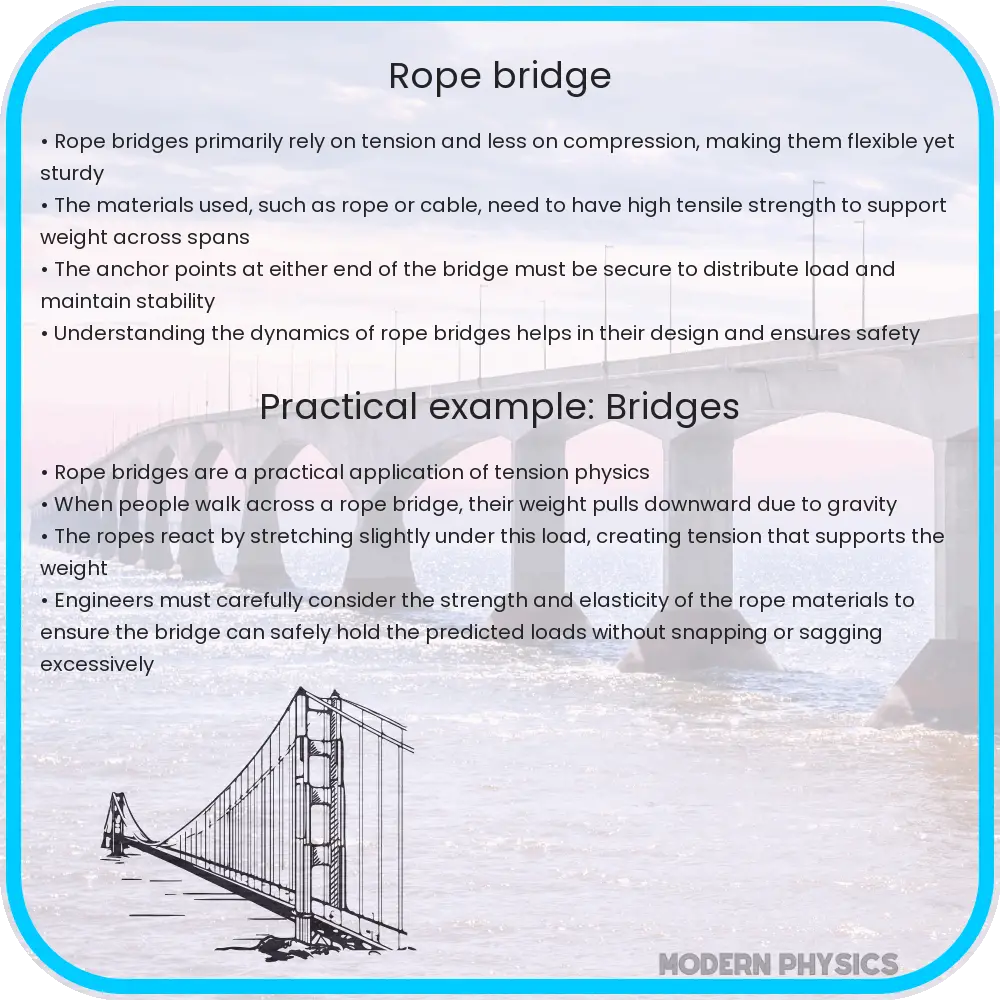Explore the engineering of rope bridges, covering materials, design principles, and their cultural significance in sustainable construction.

Understanding the Engineering of Rope Bridges: Stability and Strength
Rope bridges, often found in rugged terrains or as part of adventure trails, are a testament to the ingenious application of simple engineering principles. These bridges, primarily made of ropes and sometimes wood, are not just relics of ancient times but are also used in modern engineering due to their flexibility, adaptability, and minimal environmental impact.
Materials and Design
The primary materials used in rope bridges are ropes and cables, which are typically made from natural fibers like hemp or modern synthetic materials like nylon or polyester. The choice of material greatly influences the bridge’s strength, durability, and ability to withstand environmental factors. Wooden planks or slats are often used for the walkway, providing stability and a flat surface for passage.
Engineering Principles
Understanding the basic physics behind rope bridges is crucial. The bridge’s stability depends on tension and compression forces. Tension is the force exerted along the length of the rope, while compression affects the supporting structures like towers or trees at either end of the bridge. The key is to balance these forces to prevent excessive sway or collapse.
Strength and Load Capacity
The strength of a rope bridge is determined by factors such as the type and thickness of the ropes, the distance between supports, and the method of construction. Engineers use various calculations to estimate the maximum load capacity of the bridge. For example, the tensile strength of the rope is calculated using the formula \( \text{Stress} = \frac{\text{Force}}{\text{Area}} \), where stress is the force per unit area, measured in Pascals (Pa).
Load capacity also depends on the bridge’s design. A suspension bridge, for example, can support more weight than a simple rope bridge due to its additional support cables and towers. The dynamic load, which includes the weight of users and any movement-induced forces, must also be considered in the design to ensure safety and stability.
Environmental Impact and Sustainability
Rope bridges have a low environmental footprint, making them a sustainable choice for ecologically sensitive areas. They require minimal materials and can be constructed with local resources, reducing the need for extensive ground alterations or the introduction of foreign materials. This aspect not only preserves the natural landscape but also makes rope bridges a viable option for conservation areas or remote locations.
In conclusion, rope bridges are a remarkable example of how basic engineering principles can be applied to create stable, strong, and sustainable structures. Their design and construction require a careful balance of materials, physics, and environmental considerations, demonstrating the art and science of engineering in harmony with nature.
Challenges and Innovations in Rope Bridge Construction
Constructing rope bridges presents unique challenges, especially in remote or difficult terrains. Transporting materials, ensuring the safety of workers, and dealing with unpredictable weather conditions are some of the obstacles faced during construction. Innovative solutions, such as using drones for transporting materials or employing advanced weather prediction models, have been developed to address these challenges.
Maintenance and Durability
The longevity of a rope bridge depends significantly on regular maintenance. Natural fiber ropes, while traditional, are susceptible to weathering and need frequent replacement. Synthetic materials offer greater durability but require inspections to check for wear and tear, especially in joints and anchor points. The maintenance schedule is determined by factors like material type, environmental conditions, and bridge usage.
Applications and Cultural Significance
Rope bridges are not only functional but also hold cultural significance in many societies. In some regions, they are part of ancient traditions, linking communities and facilitating trade and communication. Modern applications extend to adventure sports, wildlife crossings, and eco-tourism, showcasing the versatility of these structures.
Case Study: The Q’eswachaka Bridge
An exemplary instance of traditional rope bridge engineering is the Q’eswachaka Bridge in Peru. Made from woven grass, this bridge spans the Apurimac River and is rebuilt annually using techniques passed down for centuries. This bridge exemplifies the blend of engineering, tradition, and community involvement, highlighting the cultural importance of rope bridges in certain societies.
Conclusion
Rope bridges, a blend of ancient wisdom and modern engineering, offer a fascinating insight into the application of simple principles to create functional, durable, and sustainable structures. Their construction and maintenance require a thorough understanding of materials, physics, and environmental impacts. The continued use and adaptation of rope bridges in various contexts reflect their versatility and resilience. From connecting remote communities to enhancing eco-tourism experiences, these bridges not only serve practical purposes but also preserve cultural heritage and promote sustainable engineering practices. As we advance in technology, the lessons learned from rope bridges can inspire future innovations in sustainable and community-centered infrastructure development.
